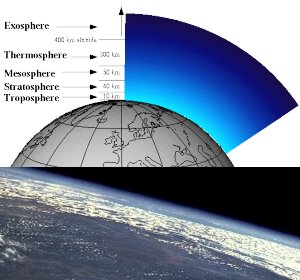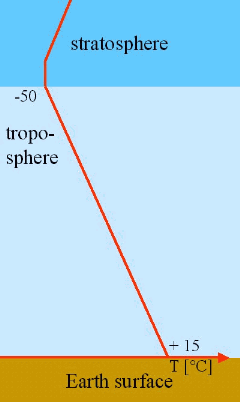 > ENC Master > Climate Encyclopaedia > Lower Atmosphere > basics > 1. Extension and composition > - vertical
> ENC Master > Climate Encyclopaedia > Lower Atmosphere > basics > 1. Extension and composition > - vertical
 |
|
|
|
Lower AtmosphereBasics
|
The Troposphere - variations with height and temperatureThe lower layer of our atmosphere, which is next to the Earth's surface, is called 'troposphere'. It is nothing else than the air surrounding us, from the ground to the highest clouds. If we look into the sky we tend to overestimate the thickness of this layer.
|
|
The atmosphere protects us from the intensive sunlight, provides the oxygen for breathing and makes life possible on Earth. But it is only a very thin cover. Dimension of the troposphereAlthough the troposphere is the thinnest layer of the atmosphere, about 11 km around a planet of 12.800 km in diameter, it contains about 90% of its mass, this means 90% of the molecules of the air.
|
|
The real world however is more complicated. We do not have the same temperature everywhere at the ground and we don't have everywhere -50°C at the tropopause round the Earth. Moreover temperature changes with the seasons. The picture gives you an idea of different temperature profiles in different latitudes in summer and winter (which is nearly the same in the tropics). Sometimes the tropospheric layer next to the ground behaves a bit different. We call it "planetary boundary layer" (PBL). In the PBL influences such as friction, heat transport, evaporation, and air pollution lead to changes within one hour. The thickness of this layer can vary between a few hundred meters and about two kilometers. The part above is called free troposphere. The most important process in the PBL is a mixing of air due to raising air in the morning.
|
|
Related pages: More about the planetary boundary layer PBL in About the layers in the atmosphere:
|
About this page:author: Dr. Elmar Uherek - Max Planck Institute for Chemistry - Mainz / Germany
|



